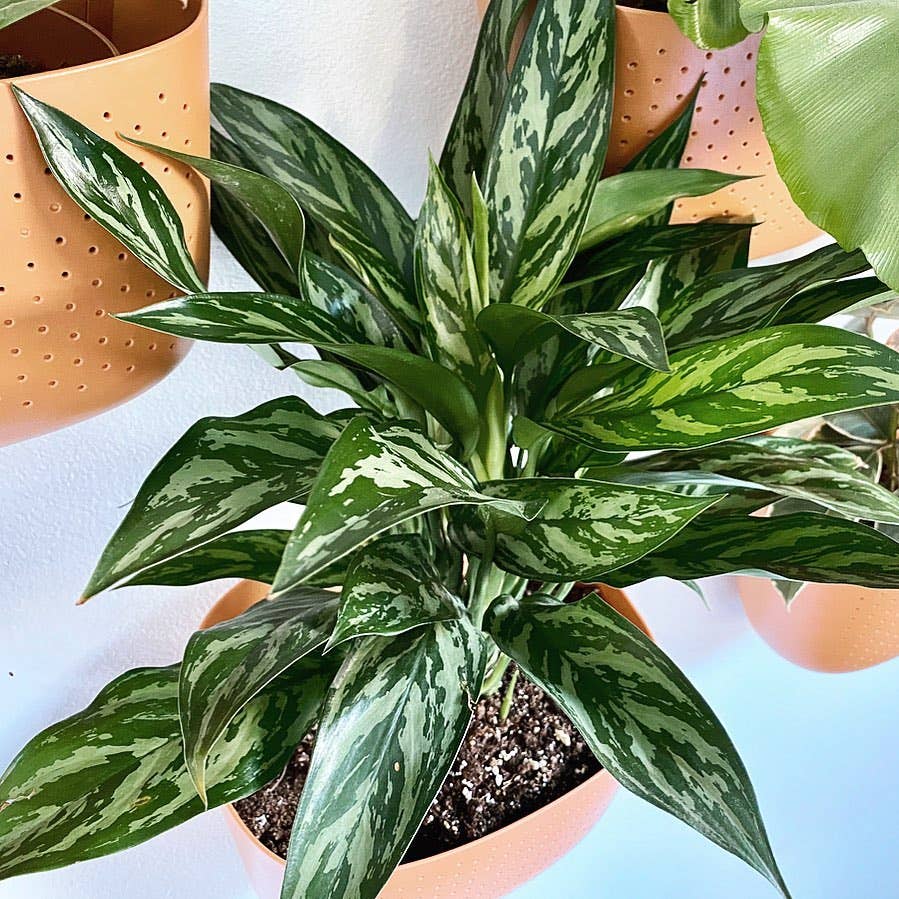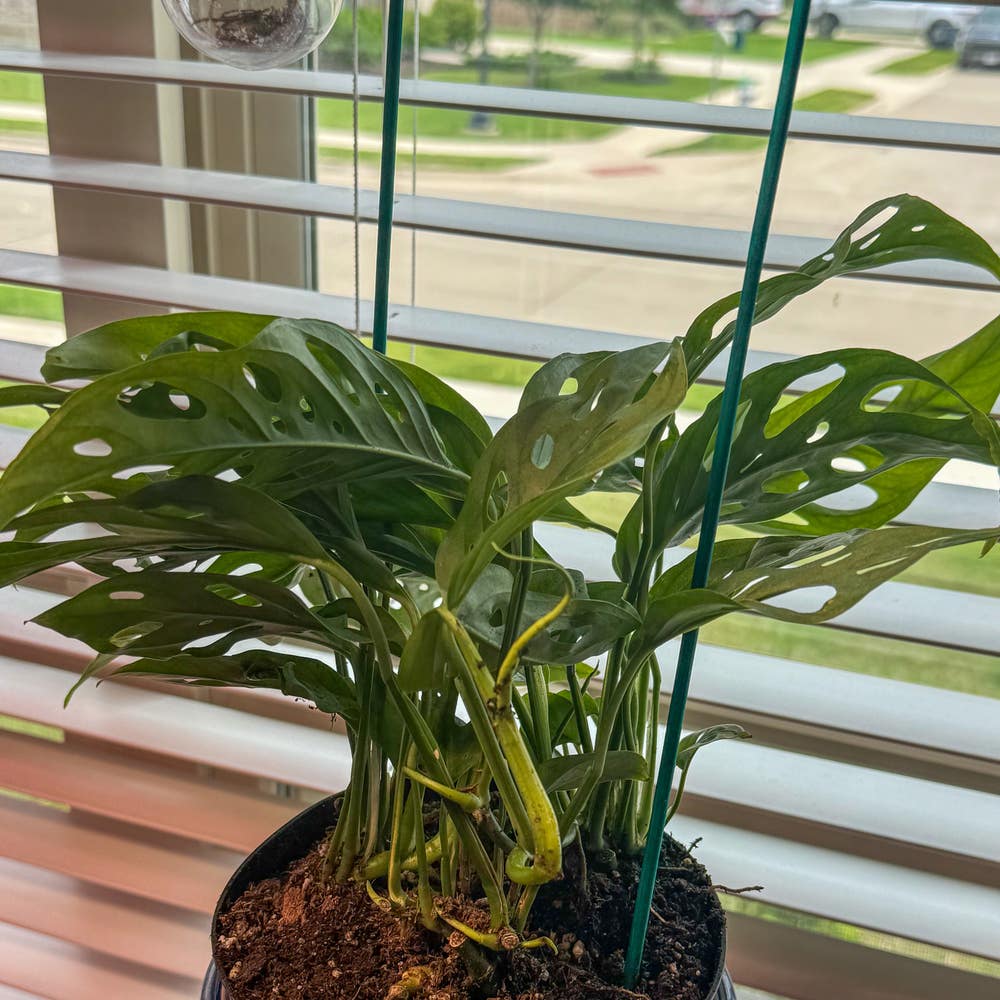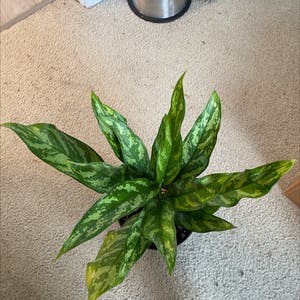




































Aglaonema 'Tigress'
Kiersten Rankel
Kiersten lives in New Orleans, LA and graduated with her masters degree in Ecology and Evolutionary Biology from Tulane University in 2019.
She has conducted or assisted on research studies covering trees such as the bald cypress, swamp maple, and water tupelo, as well as important marsh grasses including Juncus, Spartina, and Phragmites.
Kiersten is a certified Louisiana Master Naturalist and regularly volunteers with local community gardens and nonprofits to help restore critical ecosystems along the Gulf Coast.

4.5 out of 5 (2 experiences)
 Large, lush leaves
Large, lush leaves
 Pest magnet
Pest magnet
About Aglaonema 'Tigress'
Chinese evergreens have been growing in homes throughout Asia for centuries as symbols of good fortune. They were introduced to the Western world in 1885. Their ancestors were cultivated starting in the 1930s and became especially successful in Florida, where most foliage plants are now produced. 🤞
Taxonomy

Aglaonema 'Tigress'
Aglaonema
Araceae
Alismatales
Also known as
Chinese Evergreen 'Tigress'

How to care for Aglaonema 'Tigress'
How often to water your Aglaonema 'Tigress'

every 7
Aglaonema 'Tigress' needs 0.5 cups of water every 7 when it doesn’t get direct sunlight and is potted in a 5" pot.
Use our water calculator to personalize watering recommendations to your environment or download Greg for more advanced recommendations for all of your plants.

Water 0.5 cups every
7
Finding light for Aglaonema 'Tigress' in your home

a window
Aglaonema 'Tigress' can tolerate being far from a window and light source.
Place it less than 6 feet from a south-facing window to ensure it receives enough light to survive 💪.
Select your region to see how the current weather in your area affects the placement of Aglaonema 'Tigress' in your home 🏡.
How to fertilize Aglaonema 'Tigress'

Most potting soils come with ample nutrients which plants use to produce new growth.
By the time your plant has depleted the nutrients in its soil it’s likely grown enough to need a larger pot anyway.
To replenish this plant's nutrients, repot your Aglaonema 'Tigress' after it doubles in size or once a year—whichever comes first.
-
Guess what I found sprouting in my Aglaonema! I looks like a peace lily flower! But this is a aglaonema, is this common? Pretty exciting no matter what #Aglaonema
-
I noticed and treated mealybugs 2 weeks ago and 1 week ago What is this, and what should I do? Btw, the 255 character limit is ridiculous #Aglaonema
-
Raymond is in a northern window for light but it loses approx 1 leaf every 2 weeks. What should I do #Aglaonema
-
Plant accidentally fell :( So accidentally, my #Aglaonema Rotundum fell. The plastic pot didn't break, but the plant, roots and all, fell out of the pot. First I was so scared I thought the best idea was to just put everything back into the pot, but then I considered it was in contact with the floor, so that wasn't the best idea. I then cleaned another pot - a bit bigger, and it was almost time for a change in the pot size anyway - prepared a soil mix similar to the one it came in, and, well, had to repot it. This all happened very quickly, and I was worried, but now I'm looking at it - no leaves were broken, nor any roots as far as I could see - and wondering if I should have done something else? The only possible issue I can see is that when it was repositioned, I noticed the "tip" of a root coming out of the top. I covered it with soil and continued with the normal procedure. Since the plant is small - it was in a 4'' pot, moved to a 5'' one - I'm worried there's something else I should be doing. I want to make sure it survives. Any tips? :( #HappyPlants #PlantsMakePeopleHappy #PlantAddict #PlantTherapy #GregGang
-
#PlantMail Monday! Order #3 from the #GregPlantShop What a Monday Ya’ll! But ending on a much higher note now!! My goal was to go outside my comfort zone with these #GregPlantShop orders.. So have some new additions to the Plant Fam! Swiss Cheese Plant Monstera Adansonii & China Red Aglaonema 🙌🙌🙌🤠👍 I saw yours @LaSiguanaba Red Aglaonema and had to snag it up! Once again they look Great! 😱😱😍🙌 #Monstera #MonsteraMob #MonsteraMonday #Aglaonema #GregGang #GregPlantShop #theamigos #HappyPlants #PlantsMakePeopleHappy #PlantAddict #PlantTherapy
-
#GregPlantShop is pretty legit. I went in thinking I’ll only want one plant but the design of the shop gave me ideas. Even my partner agreed that the shop was nice and well designed! The unboxing shall be the next great achievement. #HappyPlants #PlantsMakePeopleHappy #PlantAddict #PLANTMAFIA #AlocasiaAddicts #Alocasia #Aglaonema #Ficus #FicusGang @alex thanks 😊
-
I was gifted this little cutie. I am not familiar with this type of plant. Can anyone confirm if Freckles is a Hypoestes polka dot plant or a Aglaonema? It is really small so I can’t really tell. Thanks in advance.🌱🥰 #HappyPlants #PlantsMakePeopleHappy #PlantAddict #NewGrowth #Aglaonema
-
No clue what I’ve done wrong 😭 Hi new friends and any #Aglaonema lovers out there. This is my first one of these, I’ve had her for like, maybe almost two years now?! She’s been a slow grower. But has been doing fine until very recently!! 😭 I fear this may be my first plant failure! Only thing that happened in recent-er days is she got repotted and new lighting, but that was still a while ago. Are these guys really finnicky? Is it humidity? Soil?? Too much light??!! WHAT DO YOU WANT FROM ME ARIA 😭😭😭 #help #Dyingplant #unhappyplants #sickplants #GregGang
-
What kind of bug is this? Found this bug on my Aglaonema this morning. I don’t see any more anywhere, but I’m not sure what it is. It was moving fast. #PestControl #pestID #Aglaonema #aglaonemapictumtricolor #help #helpneeded
-
#thegreenshouse #HappyPlants #PlantsMakePeopleHappy #PlantAddict #NewGrowth #PropagationStation #SnakePlant #SnakePlantSquad #Sansevieria #SucculentLove #SucculentLove #PlantTherapy #floweringsnake #Sanserveriaflowering #PothosPack #Monstera #CalatheaCrew #Calathea #Hoya #HoyaHangout #HoyaHeads #PrayerPlant #Philodendron #VariegatedPinkLemon #ZamioculcasZamiifolia #ZzPlant #RavenZzPlant #Aglaonema #AlocasiaAddicts #Bonsai #Ficus #FiddleLeafFig #Anthurium #WhaleFinSnakePlant #ZeylanicaSnakePlant #WhitneySanserveria #SayuriSnakePlant #Cacti #AfricanMilkBush #dragonboneeuphorbia #VariegatedOpuntia , #PricklyPearCactusvariegated https:// I am a person who normally doesn’t try new sellers, but this one popped up in my Etsy (because you viewed section) and I did some research and looked at comments so I said why not…….I received such a beautiful shipment from #thegreenshouse yesterday……Richard (I assume he’s the owner) helped me pick out 3 basic plants. They arrived in perfect condition. My heart just 💕 swelled with joy. I posted his Etsy shop above. The blooming (smells like heaven) #sansevieriablackcoral has sooo many new babies and the pot is about to bust open from the new growth. #happywifehappylife
Care Summary for Aglaonema 'Tigress'

Aglaonema 'Tigress'
 Greg recommends:
Greg recommends:
 Water
Water
0.5 cups every 7 days
 Placement
Placement
< 6ft from a window
 Nutrients
Nutrients
Repot after 2x growth
Based on the 4” pot your plant is in, and that it doesn’t get direct sunlight.

What other plant parents say
 Large, lush leaves 2
Large, lush leaves 2
 Pest magnet 2
Pest magnet 2
 Browns easily 1
Browns easily 1
 Fast grower 1
Fast grower 1

 Trending in your area
Trending in your area
 Similar to Aglaonema 'Tigress'
Similar to Aglaonema 'Tigress'

Aglaonema 'Silver Spl…

Alocasia 'Frydek'

Alocasia Dawn Variega…

Alocasia 'Imperial Re…

Aglaonema 'Pink Beaut…

Aglaonema

Albo Epipremnum Pinna…

Aglaonema 'Silver III'

Aglaonema 'Pink Anyam…

Aglaonema 'Red Valent…

Alocasia longiloba va…

Aglaonema Eileen

Aglaonema commutatum …

Aglaonema 'Green Bowl'

Aglaonema 'Snow White'
✨ Discover rare plants

Miss All-American Bea…

Pseudorphipsalis 'Blu…

Variegated Arrowhead …

Chandelier Plant

Scindapsus pictus 'Si…

Caladium

White Apple Moth Orch…

Philodendron 'Rio'

Astroloba congesta

Graptoveria 'Douglas …

Electric Blue Gecko

Maroon Pitcher Plant

Treasure Flower

Echeveria Arrow

Tillandsia caerulea A…

Anthurium 'Fantasy Lo…

Begonia lubbersii

Lavandula Pedunculata
Greg’s plant care information is derived from first-principles biology and physics and supported by peer-reviewed research, academic institutions, and industry experts. We are committed to providing the highest-quality plant care information available, so if you have any concerns about our content, feel free to reach out to our support.
- Plants for a Future. “Plant Database.” pfaf.org. N.p., n.d. Web.
- Encyclopedia of Life. “Encyclopedia of Life.” eol.org. N.p., n.d. Web.































